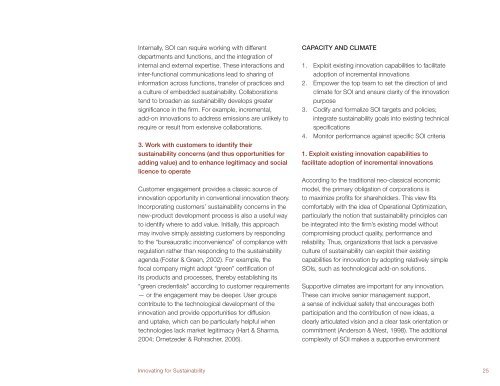Systematic Review - Network for Business Sustainability
Systematic Review - Network for Business Sustainability
Systematic Review - Network for Business Sustainability
Create successful ePaper yourself
Turn your PDF publications into a flip-book with our unique Google optimized e-Paper software.
Internally, SOI can require working with different<br />
departments and functions, and the integration of<br />
internal and external expertise. These interactions and<br />
inter-functional communications lead to sharing of<br />
in<strong>for</strong>mation across functions, transfer of practices and<br />
a culture of embedded sustainability. Collaborations<br />
tend to broaden as sustainability develops greater<br />
significance in the firm. For example, incremental,<br />
add-on innovations to address emissions are unlikely to<br />
require or result from extensive collaborations.<br />
3. Work with customers to identify their<br />
sustainability concerns (and thus opportunities <strong>for</strong><br />
adding value) and to enhance legitimacy and social<br />
licence to operate<br />
Customer engagement provides a classic source of<br />
innovation opportunity in conventional innovation theory.<br />
Incorporating customers’ sustainability concerns in the<br />
new-product development process is also a useful way<br />
to identify where to add value. Initially, this approach<br />
may involve simply assisting customers by responding<br />
to the “bureaucratic inconvenience” of compliance with<br />
regulation rather than responding to the sustainability<br />
agenda (Foster & Green, 2002). For example, the<br />
focal company might adopt “green” certification of<br />
its products and processes, thereby establishing its<br />
“green credentials” according to customer requirements<br />
— or the engagement may be deeper. User groups<br />
contribute to the technological development of the<br />
innovation and provide opportunities <strong>for</strong> diffusion<br />
and uptake, which can be particularly helpful when<br />
technologies lack market legitimacy (Hart & Sharma,<br />
2004; Ornetzeder & Rohracher, 2006).<br />
CAPACITY AND CLIMATE<br />
1. Exploit existing innovation capabilities to facilitate<br />
adoption of incremental innovations<br />
2. Empower the top team to set the direction of and<br />
climate <strong>for</strong> SOI and ensure clarity of the innovation<br />
purpose<br />
3. Codify and <strong>for</strong>malize SOI targets and policies;<br />
integrate sustainability goals into existing technical<br />
specifications<br />
4. Monitor per<strong>for</strong>mance against specific SOI criteria<br />
1. Exploit existing innovation capabilities to<br />
facilitate adoption of incremental innovations<br />
According to the traditional neo-classical economic<br />
model, the primary obligation of corporations is<br />
to maximize profits <strong>for</strong> shareholders. This view fits<br />
com<strong>for</strong>tably with the idea of Operational Optimization,<br />
particularly the notion that sustainability principles can<br />
be integrated into the firm’s existing model without<br />
compromising product quality, per<strong>for</strong>mance and<br />
reliability. Thus, organizations that lack a pervasive<br />
culture of sustainability can exploit their existing<br />
capabilities <strong>for</strong> innovation by adopting relatively simple<br />
SOIs, such as technological add-on solutions.<br />
Supportive climates are important <strong>for</strong> any innovation.<br />
These can involve senior management support,<br />
a sense of individual safety that encourages both<br />
participation and the contribution of new ideas, a<br />
clearly articulated vision and a clear task orientation or<br />
commitment (Anderson & West, 1998). The additional<br />
complexity of SOI makes a supportive environment<br />
Innovating <strong>for</strong> <strong>Sustainability</strong> 25
















